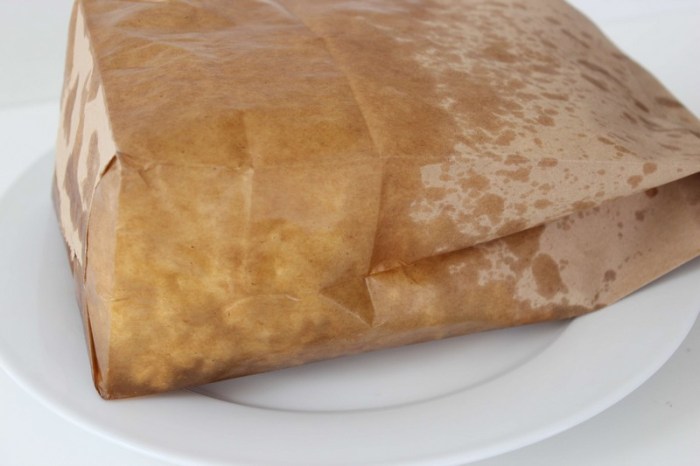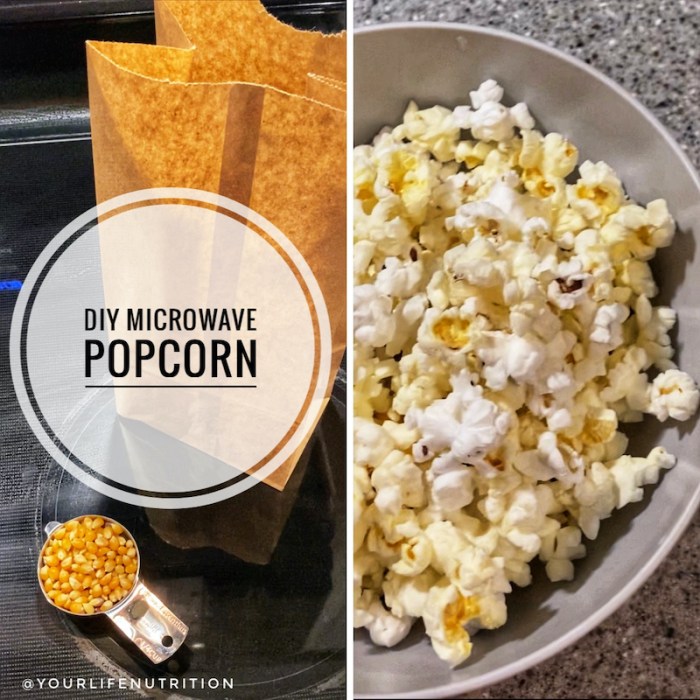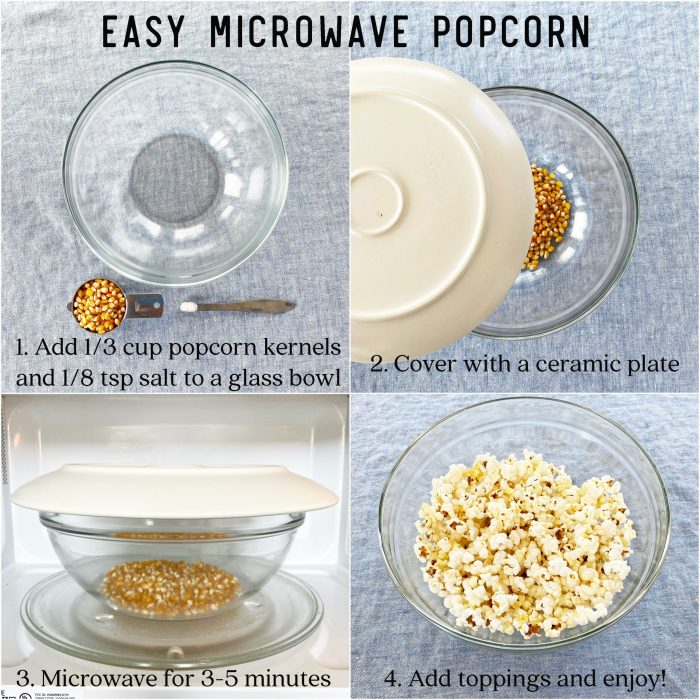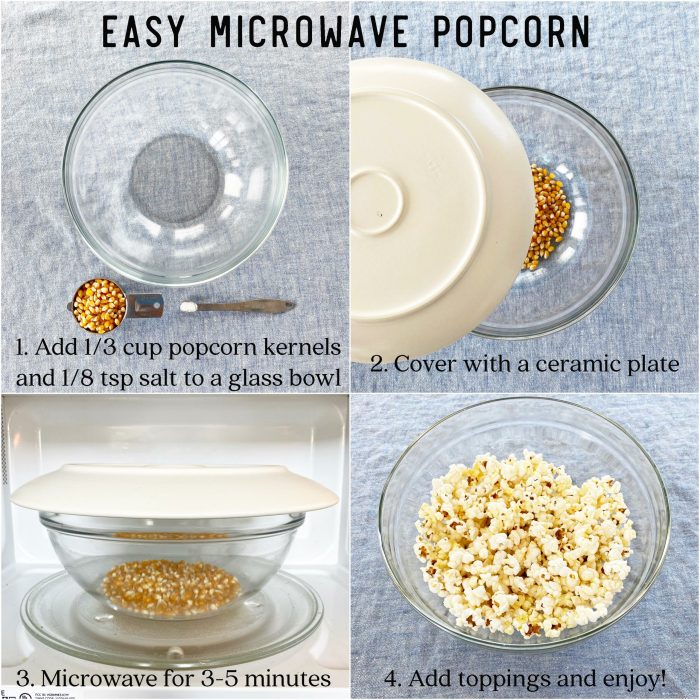DIY microwave popcorn is a fun and easy way to enjoy this classic snack at home. It allows you to control the ingredients, ensuring a healthier and more flavorful experience. By choosing high-quality popcorn kernels and experimenting with different seasonings, you can create a personalized treat that surpasses store-bought options.
This guide delves into the art of crafting homemade microwave popcorn, from selecting the right kernels and mastering the popping technique to exploring creative flavor combinations and serving ideas. Whether you’re a popcorn enthusiast or simply looking for a healthier snack option, this comprehensive guide will equip you with the knowledge and skills to pop your own perfect batch.
Essential Tools and Equipment
Making microwave popcorn at home is a simple and enjoyable process, and requires minimal equipment. You’ll need just a few essential tools to get started.
Essential Tools and Equipment
Here is a list of essential tools and equipment you’ll need to make microwave popcorn at home:
| Tool | Purpose |
|---|---|
| Microwave-safe popcorn bowl | A microwave-safe bowl is essential for popping the kernels. It should be large enough to accommodate the kernels and allow for expansion during popping. |
| Microwave | The microwave is the heart of the operation. It provides the heat needed to pop the kernels. |
| Measuring cup | A measuring cup is used to measure the correct amount of popcorn kernels. |
| Measuring spoon | A measuring spoon is used to measure the desired amount of oil or butter. |
| Spoon | A spoon is used to stir the oil or butter with the popcorn kernels. |
| Paper towel | A paper towel is used to cover the bowl while popping, helping to prevent the popcorn from splattering. |
Basic Microwave Popcorn Recipe

Microwave popcorn is a simple and quick snack that can be enjoyed at home. This recipe uses only a few basic ingredients and requires minimal effort. The goal is to create a delicious and satisfying snack with perfectly popped kernels.
Ingredients and Measurements
The ingredients are simple and readily available. You will need:
- 1/4 cup popcorn kernels
- 1 tablespoon oil (such as vegetable, canola, or coconut oil)
- 1/2 teaspoon salt
Instructions
Here’s a step-by-step guide to making microwave popcorn:
- Prepare the popcorn bag: Pour the popcorn kernels into a microwave-safe bag or bowl. Add the oil and salt.
- Fold the bag: If using a bag, fold the top over several times to create a tight seal. If using a bowl, cover with a microwave-safe lid or plastic wrap.
- Microwave: Microwave the bag or bowl on high power for 2-3 minutes, or until popping slows down significantly.
- Let it rest: Carefully remove the bag or bowl from the microwave and let it sit for a minute or two to allow the popcorn to cool and the steam to dissipate.
- Enjoy: Open the bag or bowl and enjoy your freshly popped popcorn!
Tips for Perfect Microwave Popcorn
Here are some tips to ensure you achieve perfectly popped kernels and avoid burnt popcorn:
- Use fresh kernels: Fresh popcorn kernels will pop more consistently and produce less unpopped kernels.
- Don’t overcrowd the bag or bowl: Leave some space in the bag or bowl to allow the kernels to move freely and pop properly.
- Listen for the popping sound: When the popping slows down to a few seconds between pops, it’s time to remove the bag or bowl from the microwave.
- Avoid overcooking: Overcooking can result in burnt popcorn. Remove the bag or bowl from the microwave as soon as the popping slows down significantly.
- Experiment with flavors: Add your favorite seasonings, such as butter, cheese, or spices, after the popcorn has popped.
Flavor Variations
Once you’ve mastered the basics of making microwave popcorn, it’s time to get creative with flavors! The possibilities are endless, and you can easily tailor your popcorn to your taste buds. Whether you crave savory, sweet, or spicy, there’s a flavor combination out there for you.
Savory Flavors
Savory popcorn flavors offer a delightful combination of salty, cheesy, and tangy notes. These flavors are perfect for satisfying a salty craving or adding a touch of excitement to movie night.
- Garlic Parmesan: A classic choice, garlic parmesan popcorn is easy to make. Simply toss your popcorn with melted butter, garlic powder, and grated parmesan cheese. For extra flavor, you can add a pinch of dried oregano or parsley.
- Spicy Ranch: A bold and flavorful option, spicy ranch popcorn is perfect for those who love a little heat. Mix your popcorn with melted butter, ranch seasoning, and a sprinkle of cayenne pepper for a kick.
- Cheesy Bacon: For a decadent treat, cheesy bacon popcorn is a must-try. Toss your popcorn with melted butter, bacon bits, and shredded cheddar cheese. You can also add a pinch of paprika for a touch of color.
Sweet Flavors
Sweet popcorn flavors are perfect for those who enjoy a touch of sweetness. From classic caramel corn to unique cinnamon sugar combinations, there’s a sweet popcorn flavor for every taste.
- Caramel Corn: A timeless favorite, caramel corn is a simple and delicious treat. To make caramel corn, toss your popcorn with melted butter and a mixture of brown sugar and corn syrup. You can also add a pinch of salt for a balanced flavor.
- Cinnamon Sugar: A simple yet satisfying flavor, cinnamon sugar popcorn is perfect for a sweet and warm snack. Simply toss your popcorn with melted butter, cinnamon, and sugar. For a richer flavor, you can use brown sugar instead of white sugar.
- Chocolate Drizzle: For a decadent treat, chocolate drizzle popcorn is a must-try. Melt some chocolate chips and drizzle it over your popcorn. You can also add chopped nuts, sprinkles, or other toppings for a personalized touch.
Spicy Flavors
Spicy popcorn flavors are perfect for those who enjoy a little heat. From classic chili powder to unique sriracha combinations, there’s a spicy popcorn flavor for every taste.
- Chili Lime: A bold and flavorful option, chili lime popcorn is perfect for those who love a little heat. Mix your popcorn with melted butter, chili powder, and lime juice. You can also add a pinch of cumin or garlic powder for extra flavor.
- Sriracha: For a fiery kick, sriracha popcorn is a must-try. Mix your popcorn with melted butter and sriracha sauce. You can also add a pinch of sesame seeds for a crunchy texture.
- Cajun Spice: A classic Southern flavor, Cajun spice popcorn is perfect for those who love a blend of heat and spice. Mix your popcorn with melted butter and a blend of Cajun spices, such as paprika, cayenne pepper, garlic powder, and onion powder.
Safety Precautions
Making microwave popcorn at home is a fun and easy snack, but it’s crucial to prioritize safety to avoid potential risks. While the process itself is relatively simple, understanding and implementing proper safety measures ensures a safe and enjoyable popcorn experience.
Overheating and Fire Hazards
Overheating the popcorn kernels in the microwave can lead to a fire. This happens when the kernels are heated for too long, causing them to burn and potentially ignite the bag. To prevent this, it’s essential to follow the recommended cooking time on the popcorn bag and never leave the microwave unattended while it’s running.
- Always use a microwave-safe popcorn bag and follow the instructions printed on the bag.
- Avoid overfilling the bag, as this can cause uneven heating and increase the risk of burning.
- Never leave the microwave unattended while popcorn is cooking. Keep a close eye on the process and stop the microwave immediately if you see smoke or hear any unusual noises.
Handling Hot Popcorn
The bag and popcorn inside will be extremely hot after cooking. Improper handling can lead to burns.
- Use oven mitts or a potholder to remove the bag from the microwave.
- Let the bag cool for a few minutes before opening it to prevent steam burns.
- Be careful when pouring the popcorn into a bowl, as the kernels and the bag can still be hot.
General Safety Tips
- Keep children away from the microwave and hot popcorn.
- Ensure the microwave is clean and free of debris before using it.
- If you notice any damage to the popcorn bag, discard it and use a new one.
Troubleshooting Tips

Sometimes, even with the best intentions, your microwave popcorn may not turn out as fluffy and delicious as you hoped. Don’t fret! There are a few common issues and easy solutions to help you achieve popcorn perfection.
Troubleshooting Common Microwave Popcorn Problems
Here’s a table summarizing common issues and their solutions:
| Problem | Solution |
|---|---|
| Unevenly popped kernels | Ensure the kernels are evenly distributed in the bag. Gently shake the bag to ensure that the kernels are spread out evenly. |
| Too many unpopped kernels | Check the bag’s recommended cooking time. Some bags may need a slightly longer cooking time. If the bag has a “stop popping” indicator, make sure it has stopped popping before opening the bag. |
| Burnt popcorn | Reduce the cooking time by a few seconds. If the bag has a “stop popping” indicator, stop the microwave when the popping slows down significantly. |
| Soggy popcorn | Make sure the bag is sealed properly. Over-microwaving can also lead to soggy popcorn, so reduce the cooking time if needed. |
| Popcorn with a strong, unpleasant smell | Ensure that the bag is not damaged or punctured. If the bag is damaged, discard it and use a new one. |
Creative Serving Ideas

Microwave popcorn is a classic snack that can be enjoyed in many ways. Beyond simply pouring it into a bowl, there are countless creative serving ideas that can elevate your popcorn experience.
Toppings and Dips
Toppings and dips can add a burst of flavor and texture to your popcorn. Here are some ideas:
| Topping | Description |
|---|---|
| Cheese | Parmesan, cheddar, or even a sprinkle of powdered cheese can add a savory kick. |
| Spicy | Hot sauce, chili powder, or a sprinkle of cayenne pepper can add a fiery punch. |
| Sweet | Cinnamon sugar, powdered sugar, or a drizzle of honey can add a sweet touch. |
| Savory | Herbs and spices like garlic powder, onion powder, paprika, or oregano can add depth of flavor. |
| Nuts | Pecans, almonds, or walnuts can add crunch and a nutty flavor. |
| Seeds | Sunflower seeds, pumpkin seeds, or sesame seeds can add a healthy crunch. |
| Chocolate | A drizzle of melted chocolate or chocolate chips can add a decadent touch. |
| Fruit | Dried cranberries, raisins, or chopped apples can add sweetness and a touch of fruitiness. |
Beyond the Basic Recipe: Diy Microwave Popcorn
While the microwave offers a quick and easy way to enjoy popcorn, exploring alternative methods can unlock new flavors and textures. Stepping beyond the basic microwave recipe opens up a world of possibilities for popcorn enthusiasts.
Popcorn Poppers, Diy microwave popcorn
Popcorn poppers are dedicated appliances designed specifically for popping kernels. They offer a more traditional approach to popcorn making, often resulting in a lighter, fluffier, and less oily end product.
Advantages of Using a Popcorn Popper
- Lighter and Fluffier Popcorn: Popcorn poppers typically use hot air to pop the kernels, resulting in a lighter and fluffier texture compared to microwave popcorn, which can sometimes be denser and more oily.
- Less Oil: Most popcorn poppers require minimal oil, often just a tablespoon or two, leading to a healthier and less greasy snack.
- Greater Control: Popcorn poppers allow for more control over the popping process, enabling you to adjust the heat and popping time to achieve your desired level of doneness.
- Variety of Options: Popcorn poppers come in various styles, including stovetop, air poppers, and electric poppers, offering flexibility based on your preferences and kitchen setup.
Disadvantages of Using a Popcorn Popper
- Slower Popping Time: Popping popcorn in a popper takes longer than using a microwave, requiring around 3-5 minutes for the kernels to pop.
- More Cleanup: Popcorn poppers can require more cleaning than microwaving popcorn, especially if using a stovetop or electric popper.
- Less Convenient: Popping popcorn in a popper might not be as convenient as using a microwave, especially if you’re looking for a quick snack.
Adapting Recipes for Popcorn Poppers
- Oil Quantity: Adjust the amount of oil used based on the type of popper. Air poppers generally require less oil than stovetop or electric poppers.
- Popping Time: Monitor the popping process closely and adjust the popping time as needed to achieve your desired level of doneness. Overpopping can lead to burnt kernels.
- Flavoring: Experiment with different seasonings and flavorings, adding them after the popcorn has popped to prevent burning.
The Science of Popcorn
Popcorn is a unique and beloved snack that transforms from a humble kernel into a fluffy, airy treat. This magical transformation is a result of a fascinating interplay of science, specifically the principles of heat, pressure, and moisture.
The Role of Moisture, Heat, and Pressure
The popping process is driven by the internal pressure generated within the kernel. This pressure is a result of the rapid expansion of water vapor trapped inside the kernel. Here’s how it works:
* Moisture: Each popcorn kernel contains a small amount of moisture, typically around 13-14%. This moisture is crucial for the popping process.
* Heat: When the kernel is heated to a high enough temperature (around 180°C or 355°F), the moisture inside the kernel begins to turn into steam.
* Pressure: As the steam builds up, the pressure inside the kernel increases rapidly. This pressure eventually becomes greater than the strength of the kernel’s outer shell, causing it to rupture.
* Expansion: When the shell bursts, the hot, pressurized steam escapes, causing the starch inside the kernel to expand rapidly. This rapid expansion is what creates the fluffy, airy popcorn we all know and love.
Factors Affecting Popcorn Size and Shape
The size and shape of popped popcorn kernels are influenced by several factors, including:
* Kernel Variety: Different popcorn varieties have different starch compositions and moisture levels, which can affect the size and shape of the popped kernels. Some varieties are known for producing large, fluffy popcorn, while others produce smaller, denser popcorn.
* Moisture Content: The moisture content of the kernel is a crucial factor in popping. Too little moisture, and the kernel may not pop at all. Too much moisture, and the kernel may explode violently, resulting in small, dense popcorn.
* Heating Time and Temperature: The heating time and temperature also play a role in the popping process. If the kernels are heated too quickly, they may not have enough time to develop sufficient pressure for proper popping. Conversely, if the kernels are heated too slowly, they may become overcooked and produce small, dense popcorn.
Note: The ideal moisture content for popping is around 13-14%.
The Science of Popcorn: Starch Transformation
The starch inside the popcorn kernel undergoes a dramatic transformation during the popping process. The high heat and pressure cause the starch granules to gelatinize, which means they absorb water and swell. This gelatinization process is responsible for the fluffy texture of popped popcorn.
Note: The starch in popcorn is a type of amylopectin, which is a branched starch molecule. This branched structure allows the starch to expand rapidly when heated and pressurized.
Popcorn’s History and Culture
Popcorn, a beloved snack enjoyed worldwide, has a surprisingly rich history and cultural significance spanning millennia. Its journey from ancient origins to modern-day popularity is a testament to its versatility and enduring appeal.
Ancient Origins and Early Uses
Popcorn’s origins can be traced back to ancient times, with evidence suggesting it was cultivated and consumed in the Americas long before European colonization. Archaeological findings in Peru have revealed popcorn kernels dating back over 7,600 years, making it one of the oldest cultivated crops in the Americas.
Early civilizations, including the Inca and Aztec, incorporated popcorn into various aspects of their lives. It was used not only as a food source but also for decoration, religious ceremonies, and even as a form of jewelry.
“Popcorn was an important part of the Aztec diet and was often used in religious ceremonies. It was also used to decorate temples and homes.” – Ancient History Encyclopedia
Popcorn’s Spread and Evolution
With the arrival of European explorers in the Americas, popcorn began its journey across the globe. It was introduced to Europe and later to other parts of the world, gradually gaining popularity as a snack and food source.
The 19th century saw the development of commercial popcorn production, with the invention of popcorn machines and the rise of movie theaters further boosting its popularity. Popcorn’s association with movie theaters solidified its place in popular culture, becoming synonymous with entertainment and leisure.
Popcorn in Different Cultures
Popcorn has found a special place in various cultures around the world, often with unique traditions and variations.
- United States: In the US, popcorn is a staple snack, particularly at movie theaters and sporting events. It is often served with butter, salt, and other toppings, and is a beloved treat for people of all ages.
- Mexico: Mexico has a long tradition of using popcorn in various dishes, including “esquites” (Mexican street corn) and “toledo” (a sweet popcorn treat).
- Peru: In Peru, popcorn is still an important part of the local diet and is often served as a snack or as part of traditional meals. It is also used in festivals and celebrations.
- Africa: In some African countries, popcorn is a popular street food, often served with spices and herbs.
Making microwave popcorn at home empowers you to control the ingredients, experiment with flavors, and enjoy a delicious and satisfying snack. By following the tips and techniques Artikeld in this guide, you can elevate your popcorn experience and create a truly personalized treat. So, gather your kernels, choose your favorite seasonings, and get ready to pop your own homemade goodness.
DIY microwave popcorn is a fun and easy snack to make at home. However, it’s important to be aware of potential health concerns, especially when it comes to certain medications. For instance, individuals taking valproate should consult with their doctor about the potential interactions with popcorn kernels, as it may contain compounds that could affect the drug’s efficacy.
Ultimately, enjoying your DIY microwave popcorn comes down to making informed choices and staying mindful of any potential interactions with your medications.

